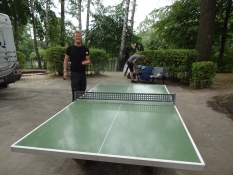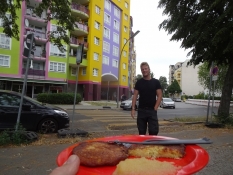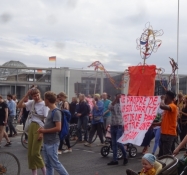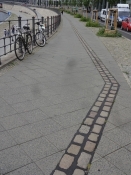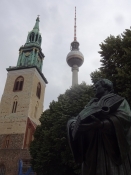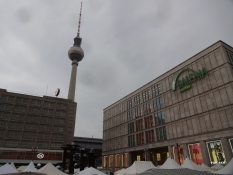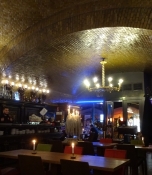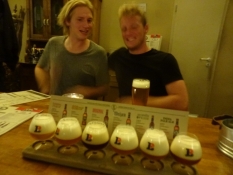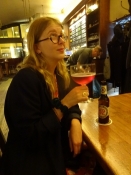Cycle Tour Bike holiday to Berlin
Dag/day 6: Berlin Spandau-Berlin Mitte
![]()
Please wait - map data are loading
Added on 11 Jul 2019
last edited by Ottocolor on 23 Oct 2019
Cycle route metrics
ridden
Total distance in km
17
Cumulative elevation gain in m
74
Avg. slope uphill in %
0,44
Cumulative elevation loss in m
67
Min. height
109
Max. height
118
Information about rights to the gps-track data | |
|---|---|
Rights owner | |
Rights characteristic / license | cc0: Public Domain no Rights reserved |
Link to the description of the license | |
GPX file uploaded | by Ottocolor on 11 Jul 2019
|
Track points in total
338
Track points per km (avg)
20
Start/endpoint
Start location
, Berlin, DE (111 m NHN)
End location
, Berlin, DE (118 m NHN)
ridden on
06 Jul 2019
Weather
In the morning overcast, but warmer and less windy. In the afternoon warm and sunny weather. In the evening rain and again windy.
Accommodation
Citystay Hostel
Rosenstraße 16
DE-10178 Berlin
Slope Gradient Distribution
Travel report
I slept poorly at Berlin's campground, because the noise from the nearby Tegel airport bothered me a lot. In addition, a rowing competition on the canal just a few meters from our tents. Through the megaphone the coxswaines shouted to the rowers and, alas, also to me inside my tent. Why they had to start at 7 in the morning, is incomprehensible to me. And we even had plenty of time today. A morning bath in nature was ruled out today, anyway and we had agreed to spend a slow morning in the campsite. Fortunately, I could buy rolls and milk in the hotel that was part of the campsite. But of course we were not allowed to have breakfast on their terrace. We did this on a bench, to which I was allowed to carry a table from the campground's beer garden. Before, I put laundry into the washing machine, with kind help of the camping warden. Only Simon had dirty laundry. Alexander is apparently also thrifty in his clothing bout. We enjoyed ambling around the site and have all the time we wanted. We also played table tennis and I enjoyed a weissbier on the hotel terrace. When the clothes were finally dry in the dryer, it was time to pack the tents together and cycle into Berlin's city centre. Here we had booked two double rooms at City Stay Hostel in Mitte, very close to the TV tower and directly opposite the Church of Mary. In the evening this Saturday, Simon's girlfriend Signe would arrive at Alexanderplatz by way of Flixbus and the subway, and then we had two whole days in Berlin together before returning home on Tuesday. But there were only 17 km into the centre, so we had lots of time. The path ran along the canal, the Hohenzollern canal, where the rowing competition had taken place in the morning. At one point, the route hit a sharp bend to the north, and it turned out to be an american football stadium we were going around. Simon told that Berlin Adler is one of the best European football clubs. They have been it turns out, for research on the web shows that they are relegated into the second best German series after five years ago winning the European championship Eurobowl. Their stadium, Poststadion, is listed because of its functionalist architecture from the 20s. It is located in the Moabit district, which is characterized by canals, large port facilities and associated old industrial plants. We approached Mitte, but first went through the Wedding working area. Here hunger attacked us without having enough provisions in my left handbag for it to settle it, so we found a small supermarket in a side street a little away from the canal we were still following. Great was my joy as I saw the fried potato pancakes in the fridge. And I know that Simon is also very happy with this German specialty, which I know from the northern German cities of Hamburg and Flensburg. Here in my childhood many Puffer-Buden could be found especially in the port area. Puffer is the German name for these little pancakes, which are made out of a dough of raw, grated potato and onions, eggs, flour and a little salt, which are then fried with diced smoked bacon and eaten with - applesauce. Yes, surprisingly enough, but apples and potatoes ("pommes de terre") go well together. So I found a big glass of apple sauce and thought I was the hero of the day. But definitely only Simon was happy, but, in solidarity with his big brother, did not really dare to express his joy. Alexander considered it too long a process to heat them on the pan instead of making sandwiches and protested loudly. But, nevertheless it didn't take long before "puffers" sizzled on the pan in the oil I had also bought a small bottle of. My problem was that my cooker was broke, so I had to ask Alexander for his. Quite an embarrassment. And he wasn't interested in that food at all. In addition, we had not found a bench with a table by the canalside and sat on a bench among the dumped garbage out to a cobblestone road and cooked and ate, so it was anything but luxury. But it was in coherence with this neighbourhood, Wedding, which is a deprived part of Berlin. I remember the German TV series "Ein Mann will nach oben", a kind of German Matador, also from the late 70s, but playing at the beginning of the 20th century. Here "the matador" Karl Siebrecht lived with his genuine Berlin under-class sweetheart Rieke, who is very simple, but cheeky as a butcher dog. At one point, she rents a tavern with her boyfriend's companion Kalli right here in Wedding, where the drinking was heavy then, simple to make life bearable and have some fun in the gray and hard everyday life. Here, where we sat, they had done a lot to bring colors into the picture by painting the houses in fairly wild colors, as can be seen in the picture.
Information about copyright | |
|---|---|
Rights characteristic / license | by-sa: CREATIVE COMMONS Attribution-ShareAlike |
Link to the description of the license | |
taken over / edited on | 27 Sep 2019 - 18 Oct 2019
|
taken over / edited by |
|
Information about copyright | |
|---|---|
Rights owner | |
Rights characteristic / license | by-sa: CREATIVE COMMONS Attribution-ShareAlike |
Link to the description of the license | |
Image has been uploaded | by Ottocolor on 16 Jul 2019
|
Information about copyright | |
|---|---|
Rights owner | |
Rights characteristic / license | by-sa: CREATIVE COMMONS Attribution-ShareAlike |
Link to the description of the license | |
Image has been uploaded | by Ottocolor on 16 Jul 2019
|
Information about copyright | |
|---|---|
Rights owner | |
Rights characteristic / license | by-sa: CREATIVE COMMONS Attribution-ShareAlike |
Link to the description of the license | |
Image has been uploaded | by Ottocolor on 16 Jul 2019
|
We still cycled along canals and port facilities towards Mitte, which is Berlin's old center. While the Wall (with a large M) stood from 1961 to 1989, it lay in East Berlin. So you can say that the Russians got to the true center of the city after the partition. The well-known Brandenburg Gate was thus the western gate of the city wall that surrounded the medieval city of Berlin. It already then merged the town of Cölln, which was as big as Berlin. This city name is recognized in the Neukölln district south of the city center. We passed a memorial park with many statues and monuments for Prussian and German army leaders, for example, from the First World War. Simon, who is very interested in this period, would probably liked to have a closer look, but we other two felt like seeing the known buildings and also reach our hostel. But we were in stead stopped by a political demonstration on the way down the Kapelle embankment. The Reichstag dome was not far away, so we were in the center now. A long procession of very colorful and costumed protesters passed for a long time. They demonstrated in favour of refugee's rights, which are often not respected. On the spot, where we waited to be able to get through the procession with our bikes, we found ourselves right where the Wall had stood, while separating the West from the East. Today it is marked by a line of cobblestones, laid in the asphalt. I think the tourist offices were tired of answering questions about this herostratically famous and disgraceful edifice and asked for it to be marked in some recognizable way that did not separate in any way after its demolition. And that is done in a nice way, I think. As mentioned earlier, there is also a cycle route that follows the wall course as closely as possible, and we did so as we passed through the protesters down the river Spree and the modern buildings that house government and parliament offices and which were built after the reunification when the (west) German capital moved from Bonn to Berlin. That East Berlin was the capital of the GDR, the West Germans have always seen as a breach of the city's four-power status, that is, the four Allied victors of World War II. The East Germans by purpose called their part Berlin - the capital of the GDR and loathed the expression East Berlin. While they considered West Berlin an independent political entity, not part of West Germany. Alas, all that has been run down the gutter of history, and the strong German economy enabled the huge task it was to move the capital to Berlin. We also saw the Reichstag building from behind. It's really striking how close it was to the Wall. And now we were also close to the Brandenburg Gate, the landmark of all landmarks and the symbol of Germany's division and unification. In the first years after the end of the partition cars and buses went through it again, but now it is only possible to walk and cycle through. So we did. The square behind, which is surrounded by the American and French embassy and luxury hotel Adlon, is called Pariser Platz and finishes the pompous streeet of Unter den Linden, which we now cycled to the east. One of the first buildings we passed was the Russian Embassy, which is in a building in 50s Stalinist coronet style. Back then, when the GDR was a Soviet satellite state, it was the center of political influence, and no East German politician could act without consulting with Soviet diplomats first. As this patronage and unreserved support disappeared during Gorbachev era and eventually completely disappeared, the GDR collapsed and the entire post-war regime was turned upside down. Nowhere in the world this is as clear as here in Berlin. As I see myself as a child of the Cold War, which, symbolically, found its end in "The Fall of the Berlin Wall," Berlin is a place I never get tired of. And there's alway something going on here. Right now, they are building a subway line under Unter den Linden, so there is plenty of unsightly road work, but the bikes clearly suffer far less than the cars from the many excavations, and we made quick progress. Mostly the many magnificent buildings made us slow down, as we could not gaze too long for road safety reasons. The last time we three "boys" had been in Berlin together was in the fall of 2006, when our home town Odense Boldklub football club played an away game against Hertha Berlin in the then UEFA Cup, and we stayed in the city for the following weekend. At that time, the Berlin cathedral from the Wilhelminian age and the burial ground of the Prussian nobility of the Hohenzollern family had stood opposite the DDR-era Palace of the Republic. Back then, the "palace" was empty and was being cleared of asbestos-contaminated materials. In the meantime, this building where the GDR's show parliament of the "People's Chamber" had sat was afterwards demolished. Instead, they are rebuilding the building that existed on the site before World War II, namely the city castle itself, which was the residence of the Prussian kings and German emperors. Nothing less. It is to accommodate the Humboldt forum, named after two famous German scientists. It seems they want to mix science and history, but nevertheless the palace was here in the first place. Yet it is widely debated whether it is a good thing to rebuild it. So far, it looks pretty messy, but the final verdict will probably look positive when it's done, even if it costs huge sums of money. I myself think it is an expression of German giantomania. Berlin has so many other things and problems to contend with, for example, the huge airport they have been building on for over ten years south of the city, near the old East German airport of Schönefeld, has still not been opened for air traffic. As ever the Germans seem to hang out for big, pompous and colossally expensive projects, and nowhere this is more evident than here in their capital.
Information about copyright | |
|---|---|
Rights characteristic / license | by-sa: CREATIVE COMMONS Attribution-ShareAlike |
Link to the description of the license | |
taken over / edited on | 18 Oct 2019 - 21 Oct 2019
|
taken over / edited by |
|
Information about copyright | |
|---|---|
Rights owner | |
Rights characteristic / license | by-sa: CREATIVE COMMONS Attribution-ShareAlike |
Link to the description of the license | |
Image has been uploaded | by Ottocolor on 16 Jul 2019
|
Information about copyright | |
|---|---|
Rights owner | |
Rights characteristic / license | by-sa: CREATIVE COMMONS Attribution-ShareAlike |
Link to the description of the license | |
Image has been uploaded | by Ottocolor on 16 Jul 2019
|
Information about copyright | |
|---|---|
Rights owner | |
Rights characteristic / license | by-sa: CREATIVE COMMONS Attribution-ShareAlike |
Link to the description of the license | |
Image has been uploaded | by Ottocolor on 16 Jul 2019
|
Information about copyright | |
|---|---|
Rights owner | |
Rights characteristic / license | by-sa: CREATIVE COMMONS Attribution-ShareAlike |
Link to the description of the license | |
Image has been uploaded | by Ottocolor on 16 Jul 2019
|
Now we only had to cross the museum island, where Germany's most amazing art treasures are on display in four magnificent museums, before we arrived at our hostel. It can not be situated more central and at the same time peaceful in a small side street almost without cars just a few steps out to the great Karl-Liebknecht-Strasse, just opposite Berlin's oldest church Marienkirche. which had miraculously been left standing after the many bombs the Allies had rained down over the city at the end of World War II. From here, it's are also not far to other top attractions such as the TV Tower and Alexanderplatz. For the time being, we just wanted to rest a little and enjoy the luxury of a bed and a double room when otherwise sleeping in a tent. As Simon would be "visited" by his girlfriend Signe a few hours later, the two lovebirds shared one double room, while Alexander and I shared the other twin room. Now we were accommodated for two and a half days stay in Berlin and we felt we had the time on our side. And we were in the opening phase and mentioned a lot of things we would like to see plus Signe had also aired a few, which Simon was smart enough to bring on now too. And we were smart enough to let her decide too. So we left the detailed planning until she joined us. Before her arrival on the subway, three of us tried to enjoy Alexanderplatz, not named after my son, but one of the Russian czars named Alexander in connection with a state visit. But the rain, which unexpectedly began to splash down, made it difficult, so we ventured into the electronics temple of Saturn. The many offerings on everything within electronic platforms didn't interest me, so I agreed to follow Simon down to the subway to receive his girlfriend. Then Alexander could just as well go along, and Simon was not allowed to celebrate the reunion with Signe in private. They had to wait until they were in their double room. Until then, we spent a wet evening near our hostel. Wet in several ways. It kept raining, but we also let some wet goods pass our throats after enjoying Vietnamese food on a good visit to the neighborhood restaurant. Simon is quick to find the kind on his phone over Google Maps. Signe, who is a vegetarian, was not impressed with the range of dishes in that segment, but we were too hungry and tired to let her drag us out into the street in further search for moss. We other meat eaters had nothing to put on the food and ate with glowing appetite. Afterwards, I suggested the nearby Hackescher Markt as tonight's venue for revival, and we did. Here, the 100-year-old Berlin subway runs above, and below there are all kinds of bars and restaurants with beautiful domes and an atmosphere of old-fashioned industry. We went to the Grand Rocka bar, which serves good beer and sophisticated drinks. Afterwards we visited the house brewery Lemke. Simon and Signe are, like me, members of the Danish beer enthusiast association, so it was an obvious choice to try some of the local brew. I went all-in and ordered a meter of beer in six small sample glasses. True beer enthusiasts appreciate diversity rather than quantity. Signe tasted the Berlin specialty Berliner Weisse mit Schuss, ie wheat beer with fruit shot. The classic shots are raspberry or wood sorrel (Waldmeister), but today you can get many different. In any case, we enjoyed our stay here brilliantly and everyone was happy that we were (re) united in this lovely city which lay at our feet for the next few days.
Information about copyright | |
|---|---|
Rights characteristic / license | by-sa: CREATIVE COMMONS Attribution-ShareAlike |
Link to the description of the license | |
taken over / edited on | 21 Oct 2019 - 23 Oct 2019
|
taken over / edited by |
|
Information about copyright | |
|---|---|
Rights owner | |
Rights characteristic / license | by-sa: CREATIVE COMMONS Attribution-ShareAlike |
Link to the description of the license | |
Image has been uploaded | by Ottocolor on 16 Jul 2019
|
Information about copyright | |
|---|---|
Rights owner | |
Rights characteristic / license | by-sa: CREATIVE COMMONS Attribution-ShareAlike |
Link to the description of the license | |
Image has been uploaded | by Ottocolor on 16 Jul 2019
|
The next two days it was "Berlin 4 4" (ie for four), where we used public transport and went on Shanks's mare on the first day and cycled on our own bikes and a rental bike the second day. The weather was good with some sun and not very hot on the first day, while we had at least one heavy rain shower on the second one and otherwise cloudy. A few weeks before our visit, they had complained of daytime temperatures of 37° C and that the naturist colony in Tiergarten had received unexpectedly large influx. There had even been rumours of complete abandon and unseemly behavior in that regard. But all that "we were spared" to witness in the cool summer weather we were met with. The first day we first took the subway to Mauerpark, where on Sunday there is a large flea market in the former no man's land between the foreland and the hinterland wall. The "wall" in Berlin consisted of two walls with various spacing. Between them, all buildings were demolished to give the border soldiers a free shot. We saw this when we went to the Bernauer Strasse near the flea market. Here, a memorial park is set up on the Wall with a chapel, the Chapel of Atonement, in the middle. Up until 1985 there had stood a church, the Church of Atonement, which had been blasted because it "stood in the way" between the walls. It had already since 1961 lost a large part of its congregation living in West Berlin. We skipped the associated documentation center on the Wall, because now it was lunch time. After that, we took the tram to the main train station, strolled through it and past the bell tower Carillon into the Tiergarten. Our goal was the documentation center for the German resistance to the Nazi regime, which is located in the very building, the so-called Bendler Bloc, where "Operation Valkyrie", the assassination attempt against Hitler and the subsequent coup d'état in July 1944 was planned and of which, unfortunately, only very little was carried out with Claus Schenk von Stauffenberg as leader and assassinator. As you will know, the bomb went off, but failed to kill Hitler. The Doku Center seems like a well-executed attempt to alleviate the German bad conscience on top of the horrors of the Nazi period. In one of the last rooms, portraits of all persons who actively opposed Hitler were assembled on one wall. When I visited the place with my mother many years ago, she said, "So many were there. And yet so few." I think that was a simple and apt comment. It must be added that as a young German she experienced that period in Germany herself. Out in the sunlight again, we now walked towards Potsdamer Platz and under the transparent dome of the Sony Center. This was one of the first new buildings in the area, and thus marked the start of the construction boom that set in on the area that had been blocked off during the Cold War and in the time of the Wall. The Berliners quickly dubbed it "Fujiyama" after the holy mountain in the company Sony's native Japan. After a cup of coffee here, we took the subway again to rest before the evening unfold. This offered a tour of Berlin's famous TV tower. As there was a wait, Simon led us to a Mexican restaurant with a supposedly excellent selection of vegetarian dishes. On the occasion of the nice weather, we had our food outside and afterwards zipped almost 200 meters to the top of the tele-asparagus, as the TV tower is dubbed by the Berliners. It is kept in true East German retro style from the late sixties with lots of imitation wood and thick, brightly colored rugs. The view from there was no cause for complaint, and the size of the city is obvious from up there. The timing was fine, because we saw the darkness sink over the city and the lights turn on. The most beautiful time of day to enjoy the view of a big city. Well down from the heights, it was time for beer boots, at least for the three gentlemen. When the 1.5 liters of beer had run through our throats, nothing much more went on that day. At least not in Alexanders and my double room! The following day, my first task was to pick up a rental bike for Signe. Today, all four of us would move on this brilliant means of city transport. Our first goal was the Reichstag Building. Maybe there was a chance to mount the famous dome of Norman Foster and look down in the federal parliament's plenary hall down below. But that was obviously impossible. The interest is so great that it requires pre-order. Instead, we took a look at people on the Paris square in front of the Brandenburg city gate as well as at the Holocaust memorial just south of with its vast, uniformly grey concrete slabs in various heights, which probably are meant to symbolize the uncertainty and lack of freedom the Jews were exposed to during the Nazi era. The Doku Center had closed as it was Monday, but it didn't matter. Instead, we cycled to Checkpoint Charlie and the museum at the former border crossing point through the Wall for foreigners and diplomats. Here the best stories af the funny ones about how East Germans tried to escape from the GDR and East Berlin. There was an Austin Mini where the petrol tank was removed in favour of a cavity where a young man in love had driven his fiancee to West Berlin. She arrived almost dead of toxic petrol vapours, but the GDR regime had been cheated yet again. Others, several hundred in Berlin alone, paid for the attempt with their lives. After this political lessons, Signe was tired of politics and suggested cycling down to the lively quarter of Kreuzberg instead, where we had lunch in a Greek snack bar in a stylish market hall. Afterwards, we cycled quite a long way down to Berlin's most beautiful bridge over the Spree, namely the Oberbaumbrücke. It is called so because there were once a number of tree trunks across the river here that marked the city's customs boundary. Here the sun was shining beautifully, but on the way "home" to our hostel we were hit by a heavy rain shower. Well, it was nice to get warm and dry again under the duvet before we cycled a short trip to the, in my opinion, most beautiful square in Berlin, the Gendarmenmarkt, which is surrounded by the quite similar dome churches of Deutscher and Französischer Dom (German and French Dome) as well as the neoclassical concert hall. Unfortunately, the square was blocked off for an outdoor concert, but we tried to sniff the mood anyway. After a single beer, it was time to drop off Signe's rental bike at the TV tower before taking the bus to the center of West Berlin. We would like to enjoy the Kurfürstendamm and Gedächtniskirche (Memorial Church) as well, so the evening was spent here. Dinner was Chinese, because it's always worth your money at such a place. Afterwards, I wanted to act like a true Berliner, hail a taxi and tell the driver: "Taxi zum Klo, please!" ("Taxi to the loo, please") That's the title of a song by the punk singer Nina Hagen from the 80s, to whom I have a certain affinity. But "Das Klo" ("The Loo") is also a nearby pub with a distinct lavatorial theme, and there we went. Thus, we drank beer from both night pots and bottles for urine, and many guests in the well-attended bar sat on toilets, which naturally contained fake turds. I don't know what Signe was thinking, but we thought she needed to expand her openmindness in this enormously openminded city. We three others had been here 13 years ago. Back then, Alexander and Simon were just small enough for that kind of thing, but the lighthearted humour around the toilet theme definitely was in their taste. (Perhaps not the right word here). This was our last night in town together, so we wanted to celebrate goodbye, because we have to say we drank inappropriate quantities of beer. Afterwards we took the bus back to East Berlin. It turned out we had to change along the way and it was something of a challenge for us in our condition. It was worse that a few stops from our hostel Alexander suddenly jumped off the bus as it stopped. He just managed to yell, he had to pee. Well, he is a grown man, but I was a bit uneasy anyway, for a master of orientation he is by no means. I usually say he can get lost in a phone booth, but he has found his way around on scooters in both Taiwan and later Vietnam, so it probably won't fit anymore. I just went to bed at the hostel, but shortly afterwards Alexander came bumping into the room. Intoxicated and sleepy, I didn't quite understand what he was saying, but the next morning, when our goal was to take the train to Hamburg and Denmark, the misery was clear for me and the others. After having relieved himself behind one of the countless barriers at Unter den Linden, he had run very fast towards the hostel, probably in an attempt to catch up with the bus. But he was far too drunk to keep his balance and sprained his foot violently by stepping into the gutter. Ouch! Do not drink and drive, but also do not drink and run, you can safely say. It was anything but a pleasant morning and farewell to our hostel and Berlin, but off we went. partly because Signe rode Alexander's bicycle while he took the bus to the main train station. He probably should have taken a taxi. Back home Alexander was at the emergency room and found that his foot was not broken but a ligament had been torn and the sprain was very severe. Still, he managed to travel alone to Vietnam and cross the long country on a scooter from south to north. So the end of our Berlin stay was bad, but it cannot ruin the memory of a wonderful stay in the city and a great cycling holiday on the way there. As I started by writing: It's something special when one's adult children appreciate reviving a tradition that lived through their childhood and adolescence. It's a special connection we have there and no one can take it from us. We even have loose plans to resume our hobby next year. In Switzerland, where the upper Rhine from its source to the mouth into Lake Constance, the so-called Alp Rhine, remains to be explored. Then possibly a biroto story can be read about that cycling holiday in a year's time. God willing.
Information about copyright | |
|---|---|
Rights characteristic / license | by-sa: CREATIVE COMMONS Attribution-ShareAlike |
Link to the description of the license | |
taken over / edited on | 23 Oct 2019
|
taken over / edited by |
|

